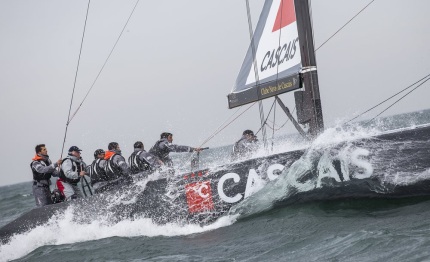RC44
RC44 Cup: Breeze on in Cascais

redazione
The forecasters had said the wind would ease, but instead torrential rain bought stronger winds which tested all 15 boats and teams competing at the Cascais RC44 Cup 2012. Sailing with their big masthead spinnakers in the first race of the day the wind increased to 28 knots, by the final run a number of the team’s fell foul to some spectacular broaches.
One team that relished the conditions was Peninsula Petroleum (GBR). They chose their favourite spot at the leeward end of the start-line in each race and went on to win the first two races before posting a solid fifth in the third, moving John Bassadone, Vasco Vascotto (ITA) and the Gibraltar based team up to fifth overall. Owner and the man at the helm, John Bassadone, was pretty pleased with their day on the water. “It was pretty scary today, actually very very exciting! We had unbelievable results and all sailed really well managing to control the boat, the crew did amazingly.”
Katusha (RUS) led the opening race of the day upto the final run before losing their spinnaker tack-line, which led to a dramatic spinnaker blow-out. With the halyard wrapped around the mainsail they couldn’t hoist their second kite and had to two-sail to the finish. “We were lucky to lose only three points on that run,” was guest helmsman Steve Howe’s synopsis after racing. The rest of the day proved less eventful, a solid second and third place followed leaving Katusha at the top of the overnight leaderboard, with a 14-point lead.
Team Aqua slotted in two sixth and a fifth to move up into second place overall whilst Artemis Racing (SWE) recovered from an average start to win the final race of the day. The team suffered two broaches right before the finish line of race one. The first was helped by a luff from Katusha, which saw the Swedes penalised for not keeping clear and incur a penalty turn. The second came on the last gybe and resulted in the spinnaker wrapping around the keel.
Morgan Larson (USA) tactician on Artemis Racing explained the conditions on the race course. “It was really tough out there today obviously windy and rainy but good action and the boats were perfect. The wind was top end for the boats but good, it would have been fairly under control if you had been sailing around on your own but when you start racing, sailing higher upwind and faster downwind with boats around you it gets pretty wild, with waves coming over the bow and into the boats, they get heavier and then you start breaking sails which is what you saw out there today.”
Photo.© MartinezStudio.es
31/03/2012 10:38:00 © riproduzione riservata
Tweet
CORRELATI
DELLA SETTIMANA
Nautica: gli scenari di mercato secondo Confindustria Nautica
Confindustria Nautica, riunita nell’Assemblea annuale dei Soci, ha presentato l’analisi previsionale sull’andamento del settore, realizzata dall’Ufficio Studi dell’Associazione
San Foca: IV regata "Più Vela per Tutti"
Un mare affollato quello di ieri al largo di San Foca, grazie ad una bella giornata di sole e di vento ‘giusto’, anche per la flotta di ‘Più Vela Per Tutti’, che ha disputato la sua quarta regata del campionato invernale
50° Invernale del Tigullio: sorridono Spirit of Nerina, Sease e Ariarace
Spirit of Nerina (ORC A-B), Sease (ORC C) e Ariarace (Rating FIV). Sono questi gli equipaggi che festeggiano al termine della prima manche del 50° Campionato Invernale del Tigullio
Giovani campioni al vento: partito a Vilamoura lo Youth Sailing World Championships 2025
Dal 12 al 20 dicembre 2025 la Marina de Vilamoura, in Portogallo, è teatro dei Youth Sailing World Championships 2025, l’evento iridato giovanile che mette a confronto i migliori talenti velici under 19 di tutto il mondo
Invernale Napoli: vincone Raffica, Eurosia Pompa Pa’ e Sly Fox Cube
L’equipaggio di Orofino vince il Trofeo Gaetano Martinelli (ORC), quello di Neri e Cassese il Trofeo Oreste Albanesi (Sport Boat), mentre il team di Fotticchia conquista il Trofeo Paola Martinelli (Gran Crociera)
Jules Verne Trophy: The Famous Project CIC verso Buona Speranza
L'equipaggio capitanato da Alexia Barrier e Dee Caffari dopo un rallentamento per un guasto meccanico viaggia spedito verso il Capo di Buona Speranza
Napoli: oltre 100 barche in acqua per sostenere Telethon
Grande successo per il Trofeo Fondazione Telethon, la regata destinata a raccogliere fondi a favore della ricerca sulle malattie genetiche rare
Trofeo Jules Verne: partito anche Thomas Coville
Sodebo Ultim 3, il maxi-trimarano francese guidato da Thomas Coville, è salpato il 15 dicembre 2025 per un nuovo tentativo di record sul Trofeo Jules Verne, il giro del mondo senza scalo né assistenza
Thailandia: una Regina in regata
Sua Maestà la Regina Suthida di Thailandia scenderà in acqua insieme al Team Thailandia per le regate della Star Sailors League
Tre Golfi Sailing Week 2026: oltre cento equipaggi da sedici Paesi per un’edizione memorabile
Più di 100 imbarcazioni provenienti da 16 Paesi hanno confermato la propria partecipazione, a testimonianza di quanto questo appuntamento sia ormai tra i più prestigiosi e attesi del calendario velico internazionale
